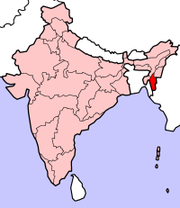Mizoram
|
|
Mizoram is a state in northeastern India. Its population at the 2001 census stood at approximately 890,000. Mizoram boasts a literacy rate of 89 percent - the second highest among all the states of India, after Kerala.
| Contents |
Ethnic groups
The great majority of Mizoram's population is comprised of ethnic Mizos. The Mizos are divided into numerous tribes, the largest of which is the Lushai, which comprises almost two-thirds of the state's population. Other major Mizo tribes include the Ralte, the Hmar, the Paihte, the Poi, and the Pawi. The Chakma, a non-Mizo tribe, is of Arakanese origin.
Religion
Some 85 percent of the population (including almost all ethnic Mizos) is Christian, mostly Presbyterian and Baptist. This Christian heritage is shared by a majority in the nearby states of Nagaland and Meghalaya, and by a large minority in neighbouring Manipur, and is one factor that helps to set the Seven Sister States (the seven states in the northeastern corner of India) apart from the rest of the country, which is overwhelmingly Hindu. The Chakma practice Theravada Buddhism, mixed with elements of Hinduism and Animism.
A minority of the Mizos have recently been observing Judaism following the announcement of a local researcher that the Mizos were one of the Lost Tribes of Israel (see Bnei Menashe). Roughly 5,000 Mizos and Kukis, a related ethnic group, have become or are the children of those who began to convert to Judaism during the mid-1980's. The state's powerful churches, which hold great sway over the lives of 750,000 Mizos—who are almost wholly Christian—dismiss this belief.
On 1 April 2005, the Chief Rabbi of Sephardic Jews in Israel, Shlomo Amar, recognized the Jewish community as authentic descendants of the Lost Tribes of Israel. The decision coupled with a gesture to send a contingent of Rabbis to India to perform formal Orthodox Jewish conversions. With the conversions, the Mizo Jews, who claim ancestry to the Tribe of Manasseh, would be allowed to move to Israel under Israel's Law of Return. Although the male side of the group was found not to have ancestral links (see Y-chromosomal_Aaron), the female side of the tribe has distinct Middle Eastern features. The difference between the masculine and feminine sides may be explained by the marriage of one of the mothers of the tribe, who came from the Middle East, to a local native.
See also
- http://news.bbc.co.uk/2/hi/south_asia/3228054.stm
- http://newswww.bbc.net.uk/1/hi/world/south_asia/3575716.stm
- http://news.bbc.co.uk/2/hi/south_asia/4400957.stm
- http://www.haaretz.com/hasen/spages/559669.html
Politics
Facts and figures
External links
- Government of Mizoram Website (http://mizoram.nic.in/)
- Government of Mizoram Portal (http://mizoram.gov.in/)
- Mizoram Portal (http://www.izawl.com/)
- Hmar.net: News, issues, articles regarding the Hmar tribals (http://www.hmar.net/)
- BBCNews: Mizo 'Jews' seek Israel visas (http://news.bbc.co.uk/2/hi/south_asia/3228054.stm/)
- BBCNews: India's 'lost Jews' wait in hope (http://newswww.bbc.net.uk/1/hi/world/south_asia/3575716.stm/)
- BBCNews: Rabbi backs India's 'lost Jews' (http://news.bbc.co.uk/2/hi/south_asia/4400957.stm/)
- Haaretz: Amar: Bnei Menashe are descendants of ancient Israelites (http://www.haaretz.com/hasen/spages/559669.html/)
- Zoram.org: Regularly updated news of Mizoram and Zo kindred tribes (http://www.zoram.org/)
Template:Indiada:Mizoram
de:Mizoram
et:Mizoram
fr:Mizoram
hi:मिज़ोरम
pt:Mizoram
sv:Mizoram

